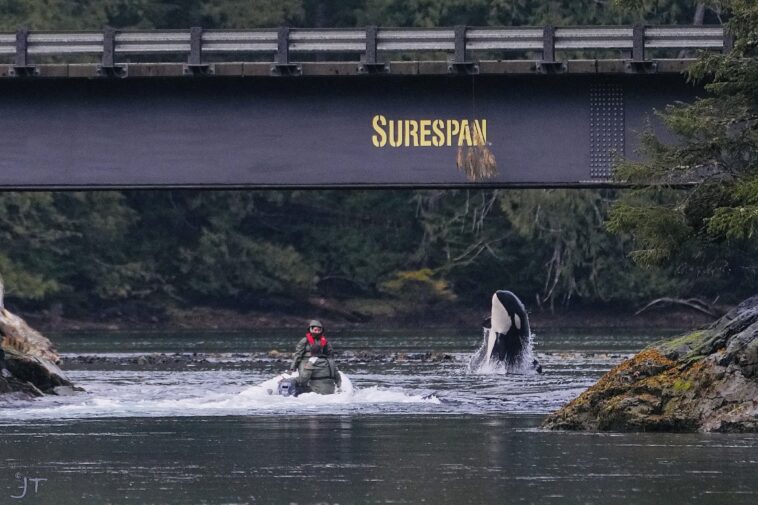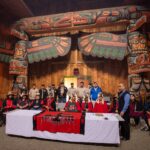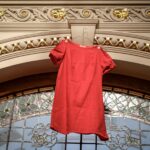West Coasters celebrated last week as the young orca who was trapped in a Vancouver Island lagoon finally swam out to sea. kʷiisaḥiʔis, or Brave Little Hunter, had been stuck in the Zeballos lagoon since her pregnant mother was stranded and drowned there on March 23. The calf became trapped by shallow waters a sandbar despite multiple attempts by a rescue team working around the clock to coax her out. Then, in the early morning of Friday, April 26, during high tide, she surprised onlookers as she made her exit out of Little Espinosa Inlet into the open ocean. We spoke with Jared Towers, Executive Director of Bay Cetology, who was on the ground as part of the marine mammal rescue team, to discuss what’s next for the young orca’s journey.
Brave Little Hunter’s location is currently unknown, Towers explained, and that’s a good thing. “We went out and surveyed the area the day after that she was free, and we didn’t see or hear her at all, which was excellent news. It just means that she’s on the move, which is great. That’s the best kind of outcome we can hope for right now,” he said.
“It’s only a matter of time really until this whale is photographed again, either by herself or most likely with another group of Bigg’s killer whales. So we just have to be patient and be on the lookout for that.”
Jared Towers, Executive Director of Bay Cetology
“There’s no real way to track the whale in real-time right now unless we had tagged it, and tagging is pretty invasive,” he said. The rescue team composed of whale researchers, Fisheries and Oceans’ Marine Mammal Response, and Ehattesaht and Nuchatlaht First Nations decided not to put the orca calf through that process. “It’s only a matter of time really until this whale is photographed again, either by herself or most likely with another group of Bigg’s killer whales. So we just have to be patient and be on the lookout for that.”
Towers and his team at Bay Cetology are relying on their wide network of people up and down the coast to send in photos to keep them updated on her whereabouts. The Skeena earlier reported on his organization’s innovative database, Finwave, which uses Artificial Intelligence (AI) technology to sort through crowd-sourced images and locate specific killer whales by their dorsal fins and other distinguishing marks.
Users from the public were invited to upload their photos into the database in order for Towers and his fellow researchers to identify Brave Little Hunter’s family pod and precisely track their movements, in hopes of eventually reuniting the calf with her relatives. Data has been collected from other whale researchers, whale-watching tours, First Nations Guardian Watchmen, the Coast Guard, and mariners of all types.
“It’s still early spring, and we anticipate that just in the next few weeks, there’s going to be a lot more people starting to get out on the water and, therefore, a lot more encounters coming in.”
Jared Towers, Executive Director of Bay Cetology
Towers told us that the T109A family pod, which includes the orca calf’s aunts, uncles and grandmother, had not been sighted in weeks, but he remains hopeful. “It’s still early spring, and we anticipate that just in the next few weeks, there’s going to be a lot more people starting to get out on the water and, therefore, a lot more encounters coming in,” he stated. He said that the Finwave database is still open to the public working off the coast of Vancouver Island who may have photos that can help identify the family pod. Any interested parties are welcome to email the organization, and they will make decisions on a case-by-case basis.
Until they are reunited, Towers said that the orca calf will be fine travelling on her own for a few weeks. “She’s proved that she can be very independent, and we also know of other killer whales in this population that occasionally get lost or purposely leave their group or are left by their group that managed to do okay for weeks at a time by themselves,” he said. “The obvious ideal outcome would be that she’ll meet up with the group, and I think that that’s very likely.”
The additional good news is that she appears to be healthy and was feeding on seal meat gifted by the Ehattesaht First Nation the day before she swam out. “We’re hoping that sustains her until she’s good to go or until she meets up with others or finds her next meal by herself,” he said.
“These animals are very evolutionarily advanced, just like we are. Part of the magic with these animals is that we feel connected to them, and a lot of people don’t know why.”
Jared Towers, Executive Director of Bay Cetology
Towers reflected on the media frenzy around Brave Little Hunter over the past month, saying the attention has revealed how almost everyone on the coast cares deeply about the well-being of orcas. “These animals are very evolutionarily advanced, just like we are. Part of the magic with these animals is that we feel connected to them, and a lot of people don’t know why,” he said. “What it really comes down to is that we’re very much alike in the way in which we live our lives socially, and even physiologically and culturally.”
“These animals tie us together across cultures and beliefs, and bind us,” he added. “When it comes to helping an orphaned and trapped orca, there’s nothing that we wouldn’t have done to help that animal.”
For more updates on Brave Little Hunter, follow the Strong Coast Facebook page.




